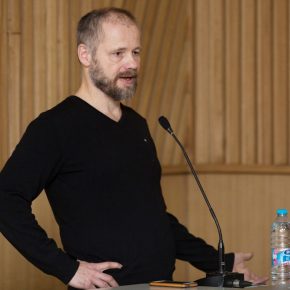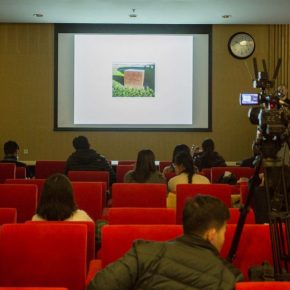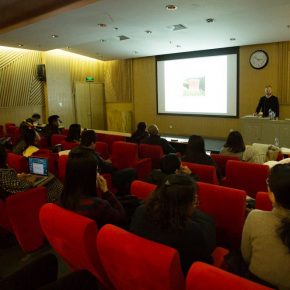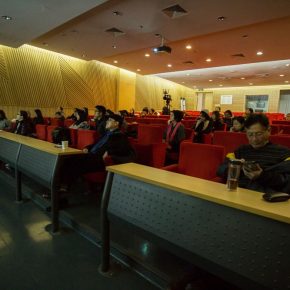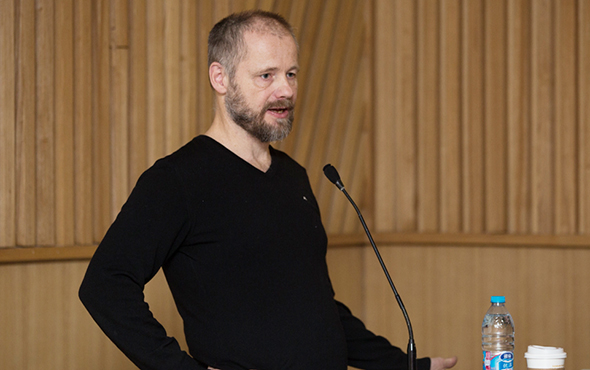
On the afternoon of January 4, 2018, Peter Callesen, a famous Danish artist, gave a lecture entitled “The White World of Peter Callesen” at the Red Chair Auditorium of Building 7, CAFA. The lecture was strongly supported by the Center of the Intangible Cultural Heritage, CAFA. Prof. Qiao Xiaoguang was invited to give lectures and dialogue. On January 6, Peter Callesen’s paper-cut art exhibition of “White World” opened at the Danish Cultural Center in the 798 Art District.
Born in Denmark in 1967, the artist Peter Callesen graduated from Goldsmiths College, London, Århus Art School and Århus School of Architecture. He has held solo exhibitions in many countries such as Denmark, England, South Korea and Germany. The artist is well-known for the A4 paper-cut creation, while he is also involved in the creation of architectural design and installation art. Peter Callesen started from the “paper” to expound his thinking of life and space with his romantic creative form at the lecture.
First of all, Peter introduced his first performing art of “Castle” practiced in London. The artist built a castle with cartons and tapes, and he disguised himself as a king. The moist and rainy weather in London quickly caused the castle to collapse, and the artist had to constantly repair and reconstruct. However, it was an idea that the artist trying to convey, that is “fighting with the impossibility”, which is also reflected in following works. Peter’s works carry the memories of fairy tales. Afterwards, “Palace of Dreams” practiced in Helsinki, Finland, is a continuation of the artist's early art, relating to childhood memories and attempting to reinterpret classic fairy tales. Peter used a boat to ferry the audience to the castle, so that they can personally experience. This floating white castle is a realm of freedom and fairy tales that the artist built for audience’s meditation.
The installation of “Earth” on display in Copenhagen expresses the theme of “We see a rotating earth in heaven”, which ridiculously and reflectively expresses the artist’s understanding of art. As one philosopher said that, “Art is something you have never noticed.” For Peter, the interesting art should have an effect of being able to make people found and realized new things that make people reflected, or more intelligent. It was inspired by the Italian artist Piero Manzoni’s work of “Socle Du Monde”, which shows the power of imagination subverting the entire world or restoring it from a subversive state. Much of Peter’s work is inspired by Piero Manzoni – of creativity, and transforming abstract concepts into real works of art at the same time.
Peter mainly introduced his A4 paper-cut artwork and “Impenetrable Castle” is the first A4 paper-cut artwork for the artist. At the beginning, the artist tried to use the A4 paper to copy a “Palace of Dreams”, which seemed impossible, but he finished it after six months, and then he created a series of A4 paper-cut works in his own unique style. All works are completed with a piece of A4 paper, perhaps cutting off part of the paper rather than adding something.
“Down the River” is also trying to expand the space to the outside of a paper. All Peter’s works portray the details, and this piece portrays a moment for a man and a boat in an upcoming horrible accidence, which gives the audience an open ending and unlimited imagination. Peter has turned a white paper into a story, and the audience uses his imagination to turn himself into a little man of the story where he can view and imagine. “Single Double Bed” expresses the theme of love, missing, or loneliness, transforming two-dimension into three-dimensional space. The majority of Peter’s works deal with light and shadow, the outline and the three-dimensional space, implying a change from the two-dimensional to the three-dimensional, expressing a deep concern about the transformation from one state of life to another.
Tragedy romanticism is a typical theme of Peter’s works. The footprints of a person and bear’s footsteps intersect at a place in the work of “Traces in Snow”, and only the footprints of bear are left after a chaos happened, so that it gives the viewer endless imaginations. The romantic painter Friedrich is also the source of inspiration for the artist. Friedrich has created many works that show the struggle between man and nature, and Peter also repeatedly uses the theme. Peter’s work also contains the reflection on life, death, religion, history and origin. He started from a small perspective to show the contradiction, tension and narrative thinking among them, which is not only reflected in his A4 works and also in the creation of large-scale framed paper-cut art. In addition, Peter has also created some large-scale works of paper-cut art.
Subsequently, Peter Callesen and Prof. Qiao Xiaoguang had a dialogue, presenting the thoughts on the history and heritage of Chinese and Western paper culture. At the end of the lecture, Prof. Qiao Xiaoguang also explained his understanding of Peter Callesen’s selection of A4 paper as the object of creation. In the internet age, A4 paper is a universal symbol of the world, Peter chose papers which are very ordinary, but the most extensive representation of the paper in the era of globalization. The “impossibility of paper” pursued by Peter is exactly the expression of the finding of the strangest possibilities. At the beginning, paper was made for two basic functions – communication and copying, and Prof. Qiao explained Peter’s art from these two perspectives. The artist breaks the flat and the two-dimensional space, to create the three-dimensional space. This new expression is diverted from the fragility and sensitivity of the paper, in order to pursue the eternal expression, time, and the universal problems that everybody pays attention to. Peter’s large-scale paper-cut art is a copy of the architectural space. In fact, his creation has never left two basic functions of paper when it was invented two thousand years ago. The significance of Peter’s creation lies in offering a strange world in the simple graphic art, when the A4 paper may disappear: in this white paper, he discovers death and sorrow, and the hidden beauty, tenderness and hope. He is contradictory, and has discovered the profoundness of the thoughts carried by paper, has discovered the depth of life and the gray & chaotic areas expressed by paper, and offering a new way of expression.
Text by Wu Huixia, translated by Chen Peihua and edited by Sue/CAFA ART INFO
Photo by Hu Sichen/CAFA ART INFO


